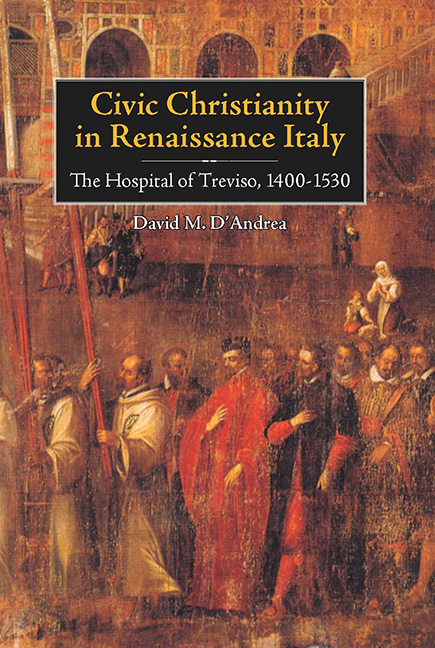Book contents
- Frontmatter
- Contents
- List of Illustrations
- Acknowledgments
- List of Abbreviations
- Notes to the Reader
- Introduction
- Chapter 1 The City of God
- Chapter 2 The Confraternal Family
- Chapter 3 The Bonds and Bounds of Charity
- Chapter 4 Medical Care and Public Health
- Chapter 5 Instruction for This Life and the Next
- Chapter 6 Crisis and Reform
- Notes
- Bibliography
- Index
Chapter 2 - The Confraternal Family
Published online by Cambridge University Press: 08 April 2017
- Frontmatter
- Contents
- List of Illustrations
- Acknowledgments
- List of Abbreviations
- Notes to the Reader
- Introduction
- Chapter 1 The City of God
- Chapter 2 The Confraternal Family
- Chapter 3 The Bonds and Bounds of Charity
- Chapter 4 Medical Care and Public Health
- Chapter 5 Instruction for This Life and the Next
- Chapter 6 Crisis and Reform
- Notes
- Bibliography
- Index
Summary
Fraternal correction is also an act of charity, since it wards off from our brother the evil which is sin. Indeed, it is even more an act of charity than saving him from outer injury or bodily harm, because the good opposed to sin, namely virtue, is closer to charity than any good of the body or of exterior possessions. Fraternal correction is an act of charity more than curing bodily sickness or relieving extreme poverty.
—Thomas Aquinas, Summa Theologiae
That no brother is to be in adultery. That no brother of the said confraternity is to make usurious loans. That the gastalds are to call quarelling brothers to peace and concord.
—Rubrics of Santa Maria dei Battuti's statutes (1400)
Confraternities were voluntary organizations, with members bound together by charity in a religious bond. The reasons individuals joined these brotherhoods were as varied as the degree and type of religious associations, but all of those who joined employed language and an organizational structure that was familial. Members were referred to as brothers and sisters who called for peace and harmony within their own organization and strove to inspire the rest of the community to Christian concord. Santa Maria dei Battuti, like all confraternities, set criteria for who could join and outlined the obligations incumbent on members. Many of the Battuti's brothers not only served their confraternity but also actively participated in the community as artisans, professionals, and communal officials. In an urban environment where status and economic activity often determined one's relationships, the confraternity provided a means for association that could extend beyond one's immediate family, profession, or parish.
On 16 November 1490, Michele Contrari died. The son of Antonio from Ferrara, Michele had migrated from Asolo to Treviso, where he entered the College of Notaries in 1442. He had joined the confraternity of Santa Maria, knowing that he would receive its material and spiritual support in times of need; he also realized that membership included certain obligations. As a member of Santa Maria dei Battuti, Contrari had served as its agent in Rome in 1454 (to compile the inventory of books from the Adelmari bequest) and acted as general syndic from 1468 to 1469. Members of the Battuti, who included his three sons Bernardino, Girolamo, and Eusebius, carried candles and sang hymns as they accompanied his body to the grave.
- Type
- Chapter
- Information
- Civic Christianity in Renaissance ItalyThe Hospital of Treviso, 1400–1530, pp. 39 - 57Publisher: Boydell & BrewerPrint publication year: 2007



